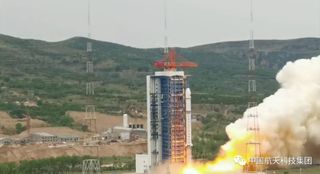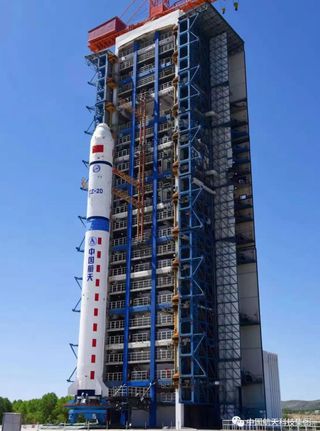China launches commercial asteroid hunter and 3 other satellites into space
The four spacecraft went up aboard a Long March 2D rocket on Thursday (June 10).

China launched four new satellites into orbit on Thursday (June 10), including a commercial satellite for tracking near-Earth asteroids.
A Long March 2D rocket lifted off from Taiyuan Satellite Launch Center in north China on Thursday at 11:03 p.m. EDT (0303 GMT, or 11:03 a.m. local time Friday, June 11). Footage of the launch shows white insulation tiles, designed to help keep fuel at the right temperature, falling to the ground as the rocket soars into the sky.
Aboard was the Yangwang-1 spacecraft for Chinese space resources company Origin Space. The firm describes (Chinese) the small satellite as China’s first optical space telescope. It has a wide field of view and collects visible and ultraviolet light to detect near-Earth asteroids.
Related: The latest news about China's space program
Origin Space plans to use Yangwang-1 to create a "treasure map" of potential space resources. In April, the company launched NEO-1, a satellite designed to release and collect a small target to simulate capturing small chunks of asteroid, and it's also planning a moon mission named NEO-2.
The other three satellites that rode to space on Thursday are called Beijing-3, Hisea-2 and TKSY01-TJ.
Beijing-3 is a remote-sensing satellite that will be operated by Twenty First Century Aerospace Technology Co., Ltd (21AT), a commercial space company. Chinese state media report that Beijing-3 will be mainly used to deliver data for resource surveys, ecological environment monitoring, fine urban management and disaster prevention and reduction.
Get the Space.com Newsletter
Breaking space news, the latest updates on rocket launches, skywatching events and more!
The satellite was developed by a subsidiary of the China Academy of Space Technology (CAST), the main satellite-making arm of China’s chief state-owned space contractor, the China Aerospace Science and Technology Corporation (CASC).
Hisea-2 is an optical remote-sensing satellite for marine ecological environment observations for Xiamen University. It was developed by the Beijing-based DFH Satellite Co., Ltd, a subsidiary of CAST. Hisea-1 was a radar remote-sensing satellite launched on the first Long March 8 rocket in December 2020.

TKSY01-TJ is a remote-sensing satellite for the Space Engineering University, the China Great Wall Industry Corporation states. The university is believed to be attached to the People's Liberation Army Strategic Support Force (PLASSF), China’s analogue to the U.S. Space Force.
The state-run Chinese outlet Xinhua states that TKSY01-TJ will be used by universities for teaching and training on in-orbit services.
All four satellites were sent into orbits that pass close to the poles with an average altitude of 308 miles (495 kilometers), according to U.S. space tracking data.
The Shanghai Academy of Spaceflight Technology (SAST), another major CASC institute, provided the Long March 2D rocket for the mission.
The launch was China’s 17th orbital mission of 2021. China next plans to send three astronauts to its Tianhe space station module in the Shenzhou-12 spacecraft late on June 16 EDT, according to airspace closure notices.
Follow us on Twitter @Spacedotcom and on Facebook.
Join our Space Forums to keep talking space on the latest missions, night sky and more! And if you have a news tip, correction or comment, let us know at: community@space.com.

Andrew is a freelance space journalist with a focus on reporting on China's rapidly growing space sector. He began writing for Space.com in 2019 and writes for SpaceNews, IEEE Spectrum, National Geographic, Sky & Telescope, New Scientist and others. Andrew first caught the space bug when, as a youngster, he saw Voyager images of other worlds in our solar system for the first time. Away from space, Andrew enjoys trail running in the forests of Finland. You can follow him on Twitter @AJ_FI.
